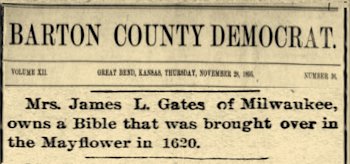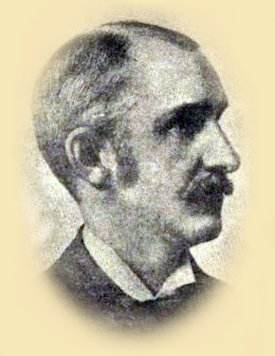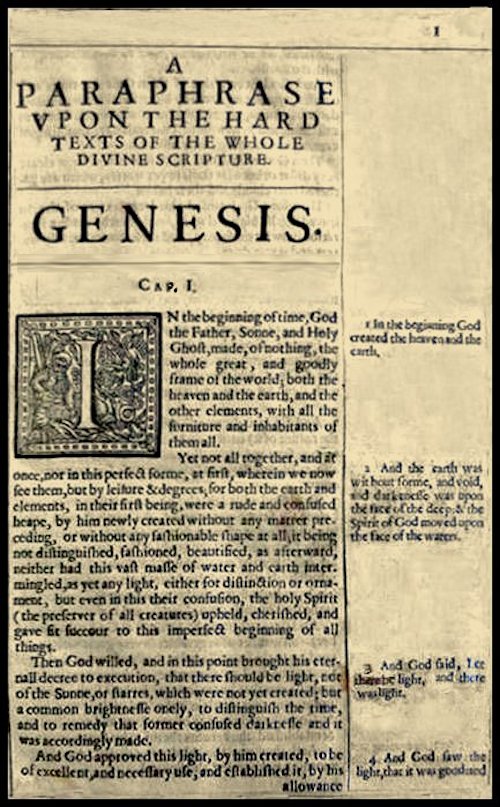
Bio: Gates, Katherine G. Mead/Meade (Mrs. James Lester)
Contact: Natalie Erpenbach
Surnames: GATES MEADE
----Source: Carolyn K. Coates Essay in Theological Librarianship (An Online Journal of the American Theological Library Association)
Katherine G. Mead/Meade Gates (6 Jul 1859 - 21 Jul 1904)
Katherine G. Gates was married to James L. Gates of Neillsville, Clark County. The family made their home in Neillsville, Wisconsin until 1887, when they moved to Milwaukee. Mrs. Gates was a member of Plymouth Congregational Church and also of the Daughters of the American Revolution. She was a musician of high merit and who spoke multiple languages. At the time of her death from tuberculosis, 21 Jul 1904, her son, Harry was 16 years old, and her daughter, Helen, was just a month away from her 14th birthday.
1860 Federal Census, Northwood, Rockingham, New Hampshire, United States
Household
John G (Gilman) Mead Male 37 New Hampshire, Merchant, $3,500 Real Estate; $1,200
Personal estate
Harriet N (Newell) Mead Female 37 New Hampshire
John G Mead Male 10 New Hampshire
Loyd T Mead Male 8 New Hampshire
Hellen M Mead Female 3 New Hampshire
Kate G Mead Female 1 New Hampshire
Joanna W Miller Female 12 Massachusetts
1870 Federal Northwood, Rockingham, New Hampshire, United States
Household
John G (Gilman) Mead Male 47 New Hampshire, $2000 Real Estate; $8000 Personal;
Dry Goods & Groceries
Harriet Newell) Mead Female 47 Massachusetts
John G Mead Male 20 New Hampshire
Loyd T Mead Male 17 New Hampshire
Helen M Mead Female 13 New Hampshire
Kate G Mead Female 11 New Hampshire
1880 Census, Northwood, Rockingham, New Hampshire, United States
1900 Census, ED 15 Milwaukee city Ward 1, Precinct 5, Milwaukee, Wisconsin

Mrs. James L. Gates (former Katherine Meade from New Hampshire) of Milwaukee, owns a Bible that was brought over in the Mayflower in 1620.
A paraphrase Bible was meant to expound on selected difficult texts. This paraphrase Bible furnishes commentary and interpretation without any of the original text. It represents the attempt to make the Bible more accessible to the average reader, and to condense the vast work into a more manageable format. Before the Reformation, such efforts to modify the text would have been condemned as heretical, but following the Reformation, it became imperative to make the Biblical text comprehensible to the layman as well as clergy.
********************************
"The Curious Case of a “Mayflower Bible”
by Carolyn K. Coates
(excerpts and paraphrase/inserted pictures)
********************************
Clearly the book (owned by Katherine G. Meade Gates), was a family heirloom of some importance. Our donor, Mr. Jack Connell, had no specific recollection of where he had obtained the book. Some years before, he had had a business cleaning out attics and garages all over eastern Connecticut and this was something that he had acquired along the way. He brought it to Eastern (Theological Library). Someone....had told Mr. Connell the book dated from the early seventeenth century. The several pieces of ephemera (not as old) tucked between the pages of the book documented some of the history of the volume itself.
On March 9, 1896, James L. Gates, of Milwaukee, Wisconsin, wrote........
“This Bible is the King James Edition, published A.D. 1611. It came over in the Mayflower in 1620 and was in the possession of the Winthrops who married into the Hilton family of Newburyport, Mass., who afterwards moved to Newmarket, N. H. The Hiltons married the Meades and this book has been in the Meade family for four or five generations, to-wit: “From father to son until John G (Gilman). Meade of Northwood Center, N. H. gave it to his youngest daughter, Mrs. James L. Gates, in the summer of 1893 for exhibition at the World’s Fair in Chicago. Previous to 1893 this Bible had been in the same house (still belonging to Mr. Meade) over 175 years, and the house is in a better state of preservation today than the book is. “This Bible was also used by the John Howland family. The Howland family married into the John Thompson family and the Thompsons into the Meade family….” “Mr. Gates is not in it.”

James Lester Gates (1850 - 1911)
Buried in Neillsville, Clark Co., WI
James L. Gates ..........well-known and regarded for his logging, banking, and other business enterprises in Neillsville and, later, Milwaukee, Wisconsin. Indeed, his written claims.........seemed quite in keeping with his wife’s distinguished genealogy (the Mayflower provenance is all but assumed). One note tucked inside, looks to be of more recent origin, outlines the history of the family of William Hilton, a Plymouth colony settler who immigrated on the Fortune, the second ship to arrive at the colony. Did our book arrive on the Mayflower, or the Fortune? Was it an early King James Bible? The book certainly had the patina of age, and the printing suggests a book of that era, though without a title page or colophon, it was hard to confirm. The first task was to determine exactly what book Mr. Connell had found.
There were reasons to doubt the Mayflower connection. I had my doubts about both the King James and Pilgrim connections. Just a year earlier, I'd had the chance to examine an authentic King James Bible up close. Unlike the volume in our library which measures approximately 29 cm by 22.5 cm by 7 cm, the early printings of the Authorized Version were larger books. A quick bit of research favored the Geneva Bible, a translation produced by the English Marian exile community in Geneva, which went through numerous editions in the late sixteenth century.
I started scanning bibles from the 1600s, looking up Exodus and Leviticus, the earliest surviving sections of the volume in hand. The ruled pages were providing a clue that I should have taken more seriously from the start. The text on the pages reproduced the books of the bible in their conventional order, but the chapters seemed too short. Comparing the volume at hand with a modern bible confirmed immediately that this book did not reproduce the entire text of the bible. I found a perfect match. This book was not a bible per se, but a biblical commentary published in 1633 to aid preachers in their preparations of sermons. I find it interesting that all of us—a succession of previous owners, the donor, and several librarians—had taken the idea that this book was a bible for granted, even as we had our misgivings at the Mayflower claim. The English language of 1633 May be comparatively “modern” but that 1896 letter was much closer in time, more familiar, and more easily readable than the seventeenth century typography and literary style of the book.

|
A biblical commentary by “Ios. Exon.” aka Joseph Hall (1574-1656) Published in 1633 as Preacher's Aid Special Collections, Golda Meir Library |
Now that both the author and title were known, it was reasonably easy to place both in their historical contexts. “Ios. Exon.”, better known as Joseph Hall (1574-1656), was a prominent Anglican divine of the seventeenth century who rose from modest beginnings to extraordinary prominence.
The first mystery had been solved: this book was published a good while after the sailing of Mayflower and of the Fortune. Yet in other ways, the mystery had only deepened.....Was that a deliberate attempt to deceive, or did it perhaps describe another book, a real Mayflower Bible now lost? If the intrepid Mr. Gates was wrong about this fact, what could we make of the rest of his letter? And if the book was located in Wisconsin in 1896, how did it end up in Connecticut in 2007?
I learned that Gates married his second wife, Katherine G. Meade, in 1885. The twelfth U.S. Census of 1900 records the Gates family of Milwaukee, Wisconsin, which included James L. Gates, Katherine M. Gates, listed as having been born in New Hampshire in 1859, and their two children, Harrison, born 1889 and Helen M., born 1891. Two servants also lived with the family. Following this genealogical trail (and feeling more and more like one of the History Detectives) I was able to trace the family line back to New Hampshire through Katherine’s father. An ancestor is recorded as having signed the Association Test of 1776, signaling his assent to opposing British rule in the colony. Thus a basic tenet of Gates’s genealogical provenance for the book is sound: the Meade family had been associated with southeastern New Hampshire for a number of generations before Katherine was born. Another tenet of Gates’s account lies with the Hilton family. I was also able to trace this line back to early New England, with connections to Edward Hilton (1596-1670/1671), one of the first English settlers in New Hampshire, and through marriage to other prominent early settlers and their families including John Winthrop, the first governor of the Massachusetts Bay Colony, and Thomas Dudley (1576-1653), John Winthrop’s deputy governor, compatriot, and occasional adversary whose most famous offspring was Anne Bradstreet, the noted poet. It is tempting to theorize that our book passed through the hands of one of the Winthrops or Dudleys, Corthell, “Joseph Hall”, “James L. Gates,” Good Old Days, Clark County Press (Neillsville, Wis.), 28 May 1997 as transcribed by Sharon Schulte:
An unsigned article in the Wisconsin State Journal (Madison) on Friday, November 26, 1926 is headlined “Mayflower Bible Displayed in City.” The article mentions that a bible brought over on the Mayflower in 1620 is on exhibit in the window of the Electric Refrigeration Company at 401 State Street, “together with an issue of the Boston Weekly Messenger of 1812, two ancient deeds, and a few pasteboard bills representing 15 shillings in continental money.” The author tells us that the bible is the property of James L. Gates of Cambridge [Wisconsin], recounts Mrs. Gates’ lineage, and describes some of the book’s marginalia (despite his being mentioned in the article, James died in 1911 and Katherine in 1904). This was the second time that the book, in its guise as a Mayflower Bible, had been on public display, the first time being at the World’s Columbian Exposition in Chicago in 1893, according to the Gates letter. In both instances the book’s exhibition seemed to pass unquestioned—
Our book seems to have been on display as something a “prop” for the telling of a story other than its own, one in which a politics of “progress” and national identity rests upon theological—or perhaps simply cultural—assumptions about beginnings and purity of purpose. What can it tell us of the use of books in American history? Joseph Hall’s paraphrase has bits of marginalia scattered through the pages......” The source of the connection between this book and the Mayflower May be a note written on page 384, just above Jeremiah 10:2: “May Flower landed 1620.” Rather than recording the event as it happened however, I think it more likely that this May have tied into the writer’s reflections on the text of Jeremiah: “And bee not dismaid at the signes of heaven for the heathen are dismaid at them…” Perhaps a sermon was in the works on the providential nature of God vis-à-vis the heathen and the saints. One of the lengthier and more intriguing marginal notations recounts an unusual weather event that came to be known as the “Dark Day of 1780.” Written in black ink with a very fine pen in a neat hand, near the start of Ephesians, we found: “May 19, 1780 A darkness came on about 11 o’clock, and continued till 3, people were obliged to light candles in the house the darkness being so great. Lights might be seen to shine in the houses at a distance as at night. All business out of doors was dropt.” This May have been written in what was simply a convenient break in the page layout, or it May have been intentionally placed over Ephesians 1:3, which refers to blessing in heavenly places. “The Dark Day” is conventionally attributed to smoke from fires used to clear land that must have intersected with some unusual weather patterns. Some felt that it portended Doomsday or the Last Judgment, while other felt that work must go on. Gradually the sky cleared and stars became visible later that night.
Ephemera tucked into the volume offers more fulsome records of eighteenth century events. A duplicate receipt is included, noting the payment of eighteen shilling 10 ½ in excise taxes in Newberry Port (or Newburyport in modern terms), a sign of a significant business transaction, perhaps. Another handwritten note, this one pasted into the book, outlines the raising of a committee, consisting of Mr. Wentworth Cheswick, Mr. Ichabod Hilton, and Mr. James Cram, to procure the men needed to fill the town’s quota in the Continental Army in 1781. This note has been pasted directly below Ezekiel 48:19, “And they that serve the city, shall serve it out of all the tribes of Israel,” a reference to the need for all groups to contribute.
Given its age, the book May have gone through several owners and readers before the first elements of the marginalia were added to the printed text. Some time early on it served as study aid and guide for a preacher preparing sermons and otherwise studying scripture—just as the author intended—and came to a serve also as a repository for notes on his sermons and his congregation. Later, more notes were added, as were family names. Although it May have served several functions simultaneously, it seems to have undergone a long, gradual transformation, The Encyclopedia of New England: The Culture and History of an American Region, edited by Burt Feintuch and David H. Watters; foreword by Donald Hall (New Haven: Yale University Press, 2005), 548-549, suggests smoke as the reason for the darkness, as does Sidney Perley, Historic Storms of New England (Beverly, MA: Memoirs Unlimited, 2001; reprinted from Salem, MA: Salem Press Publishing and Printing Company, 1891), 87-96. Some ash fell with rain, corroborating the theory. Perley reports that the Connecticut State Legislature called for candles to be lit so that deliberations could continue, though some thought that they might better adjourn and prepare themselves for the Judgment. Theological Librarianship An Online Journal of the American Theological Library Association 14 Volume 1, Number 2 • December 2008 from theological study guide and biblical commentary to family heirloom and repository of pride in family history. Further study of the relationships between these elements of the book—its text, its marginalia, its attending ephemera—holds possibilities for further study and insights into the American histories of the book and of biblical interpretation.
One question remained: how did so obviously cherished a family heirloom come to be—essentially, if unintentionally—abandoned? A small scrap of yellowing paper, with notes neatly written in pencil in a twentieth century hand. It had been clipped to the pages, and the rust from the paper clip has stained both the note and the pages of the book. On one side it reads:
“Mr. Gates— Harry M. 3707 W. Scott. Mayflower Bible—printed 1611 came to America 1620 in possession of the Winthrops. Family heirloom.” The other side reads “Inez Emmons, Bay View Bap. —Mr. Eads’ Great grandfather’s Bible.” This note contains a clue as to how the book traveled east, but it is also poignantly suggests how clues of family history easily become lost. In the moment represented by this note, “Meade” has slipped back past a previous spelling of “Mead” to “Eads.”
In this slippage, we see the potential for a loss of historical memory. Even so, we do know that Harry Gates, of the note, is Harrison Meade Gates (1889-1974). According to genealogical sources, Harrison married, had four daughters, and divorced sometime prior to 1937. He later married Alma Louise Nichols, and according to an obituary published in the Willimantic Chronicle September 16, 1974, moved to Mansfield, Connecticut, near her home town of Windham, in the late 1950s, about a year after his retirement from a company in Milwaukee.13 Alma Gates died a few years later. Both Harrison and Alma Gates are buried in the North Windham cemetery, just a few miles from the the library where this book came to rest. It was probably at the Gates home in Mansfield, or somewhere in Willimantic, where Alma was living when she died, that Mr. Connell found the “Mayflower Bible” that he donated to Eastern.
********************************
BioM: Katherine G. Mead (02 Jul 1885)
New Hampshire Marriage Records, 1637-1947
Groom: James L. Gates, 34 yr. old male
Marriage Date:
02 Jul 1885
Location: Northwood, Rockingham, New Hampshire
Birth Year (1850):
Birthplace: Essex Co. NY
Father's Name: Daniel
Mother's Name: Jane Hewett
Bride's Name: Katherine G. Mead, 26 yr. old female
Bride's Birth Year (Estimated 1859):
Bride's Birthplace: Northwood, Rockingham, NH
Bride's Father's Name: John G (Gilman).
Bride's Mother's Name: Harriett M. Thompson
Record Number: 1614
|
© Every submission is protected by the Digital Millennium Copyright Act of 1998.
Show your appreciation of this freely provided information by not copying it to any other site without our permission.
Become a Clark County History Buff
|
|
A site created and
maintained by the Clark County History Buffs
Webmasters: Leon Konieczny, Tanya Paschke, Janet & Stan Schwarze, James W. Sternitzky,
|